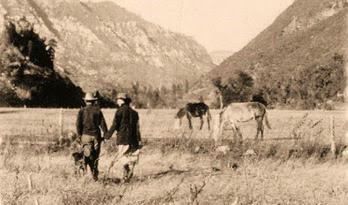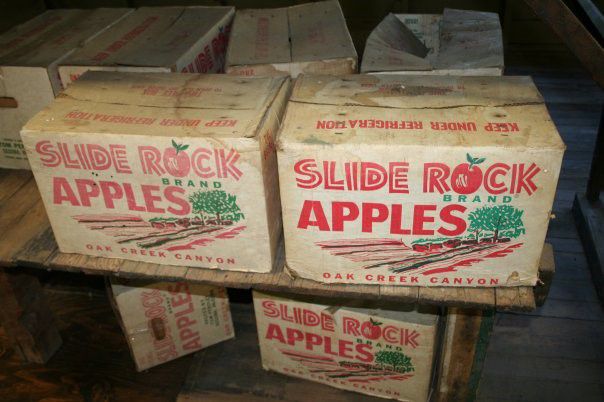Meet Arizona Agriculture’s Pendley Family
Author
Published
2/1/2018
Have you ever been to Slide Rock State Park in Sedona, Arizona? Although hundreds of thousands of people visit the park each year, many are unaware of its deep-rooted history in agriculture.
Did you know this popular tourist attraction was once better known for its apple trees? This State park was once better known as the Pendley Homestead. Although it has been purchased and operates as a state park, you will still find apple trees lining the trail to the slippery rocks. In fact, you can still see one original tree that was planted over 100 years ago. The history of the Pendley Homestead from Kathy Pendley Shaw, the Granddaughter of the original homesteaders is as unique as Arizona.
An ongoing series about Arizona agriculture’s farmers and ranchers.
Interview with Kathy Pendley Shaw of Sedona, Arizona.
Tell us About your Apple Homestead : My Grandfather, Frank Leslie Pendley, came to Oak Creek Canyon in 1907 and found the perfect property to homestead and raise apples. The original homestead patent was for 51 acres, the Park is now 43 acres in the heart of beautiful Oak Creek Canyon.
Agriculture was very important in the late 1890’s and early 1940’s. And, apples were a very important crop. The apple trees found in Oak Creek Canyon require around 1,200 chilling hours. Chilling hours are the cold temperatures found in winter that put the trees into dormancy so they can renew and store the energy needed to produce fruit. The canyon also has the good soil and lots of water, both things are needed for the trees to produce fruit.

Grandpa Frank planted many varieties of apples on the homestead; Arkansas Black, Stark King double red delicious, Golden Delicious, Grimes Golden, Winesap, Rome Beauty, Jonathan, Wolf River, King David to name a few. My personal favorite eating apple is the Grimes Golden delicious. It’s flavor profile is the perfect blend of tart and sweet! For cooking I love the Winesap, Wolf River, and Arkansas black. For cider it’s the Akane! The park has just a few of these trees planted in the 1990s by a group of Master Gardeners. The Akane is the first variety to ripen in mid-August, with the other varieties ripening throughout September.

The trees Grandpa planted are Standard-size trees. They can be up to 30 feet tall, monsters in size compared to the dwarf and semi dwarf trees favored by growers now days. The trees required 8 to 12 years to bear fruit. He spent the first two years of this time building his unique water system that included two tunnels and suspended flume 80 feet above the creek in the sandstone cliff. There wasn’t much free time for him from 1910 to 1920!
My Grandfather died in 1954. At that time, the Ranch had over 750 apple trees. In a good year 8,000 bushels were harvested! In the early days there wasn’t enough customers in the Canyon to market the apples there. Grandpa trucked them to other markets, Williams, Flagstaff, Winslow, Holbrook, the Verde Valley, Jerome, Prescott, Phoenix, Tucson. Keep in mind, that was by the highway system as there weren’t any interstates then. A trip to Phoenix would take 5 to 6 hours via 89A through Sedona, Cottonwood, Prescott, Yarnell, and Wickenburg.
In years with big crops, grandpa would sell boxcars full of apples to go by rail (train) to Los Angeles. This of course was after they were picked, polished, and packed. He built a Packing Shed in 1932 that we still use today. As a matter of fact, I packed apples there this afternoon! The machinery is a Bean Cutler polisher and sorter. A simple and elegant machine that was and is easy to maintain. Important as the Pendley Homestead equipment was like that found on most farms, repaired and maintained by the farmer. You must be a mechanic, botanist, hydrologist, marketer, and entrepreneur to be a successful apple Farmer!
My Father, Tom Pendley, took over the farm operation from 1963 until 1985 so I spent my childhood between Phoenix in the winter and spring and Oak Creek from the Summer through harvest in the fall. Dad brought some new agricultural practices to the Homestead, specifically using irrigation pipes to irrigate the crops. This change from flood irrigation allowed him to use the water in a more efficient manner which also conserved more water. I grew up being interested in the history of the area and have been a historian for SRSP since 2009. I also grew up with an interest in growing food and took the Coconino County Master Gardener course in 2010.
If you visit Slide Rock, be sure to stop and look at the apple trees. You might even see Kathy working in the orchard!
Join Our Family